Dates 14 Sep 1812 – 18 Sep 1812 | Location Moscow, Russia | |
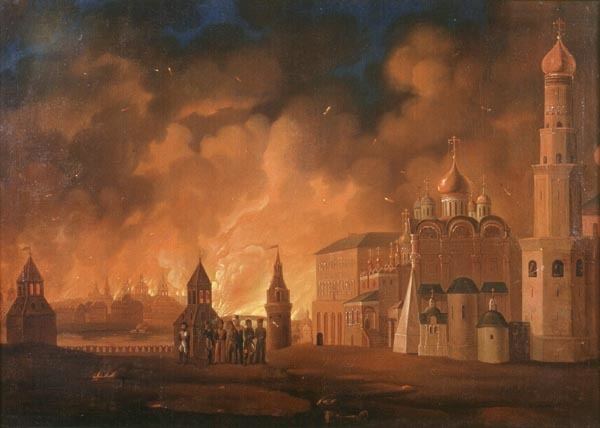 | ||
Similar Moscow plague riot of 1771, Khodynka Tragedy, Great Chicago Fire, Great Fire of Toronto, Great Fire of London | ||
The 1812 Fire of Moscow broke out on September 14, 1812 in Moscow on the day when Russian troops and most residents abandoned the city and Napoleon's vanguard troops entered the city following the Battle of Borodino. The fire destroyed almost entire city of Moscow. The majority of Moscow residents left the city during August 1812.
Contents
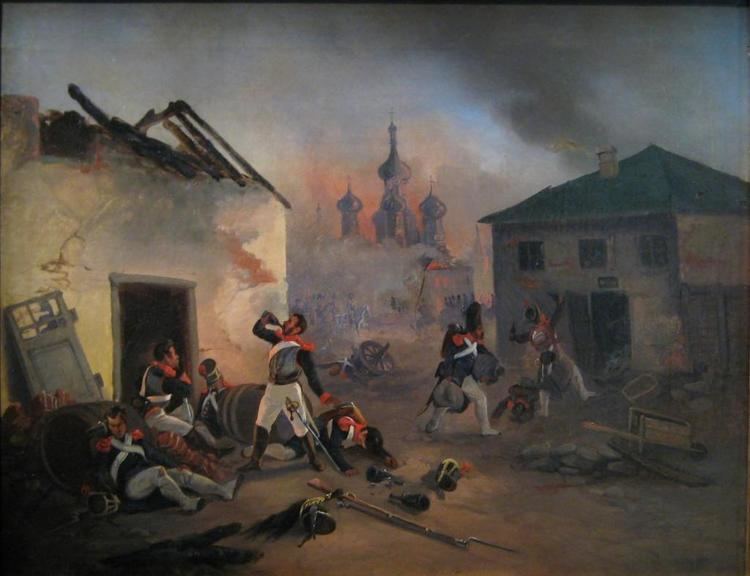
Causes
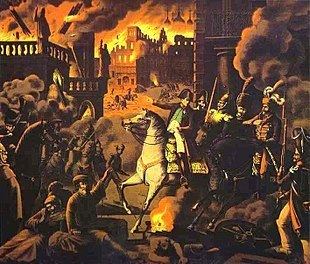
Before leaving Moscow Count Rostopchin gave orders to have the Kremlin and major public buildings (including churches and monasteries) either blown up or set on fire. But this was not the foremost cause of the fire that destroyed the city. As the bulk of the French army moved into the city, there were some fires. Their cause has never been determined and both neglect as well as Rostopchin's orders may be among possible reasons. Today, the majority of historians blames the initial fires on Russian sabotage.
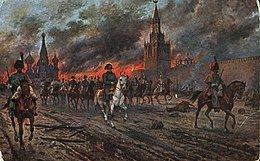
This version of events is confirmed by General Armand de Caulaincourt. He states that they had been in Moscow for three days. That evening a small fire had broken out but was extinguished and 'attributed to the carelessness of the troops'. Later that evening (10h 30min) Coulaincourt was woken by his valet with the news that 'for three quarters of an hour the city has been in flames'. Fires continued to break out in multiple separate points. Incendiarists were arrested and interrogated and declared that their commanding officer had ordered them to burn everything. 'Houses had been designated to this end.' Later on in the same chapter he asserts 'The existence of inflammable fuses, all made in the same fashion and placed in different public and private buildings, is a fact of which I, as many others, had personal evidence. I saw the fuses on the spot and many were taken to the Emperor.' He goes on to write 'The examination of the police rank-and-file… all proved that the fire had been prepared and executed by order of Count Rostopchin'.
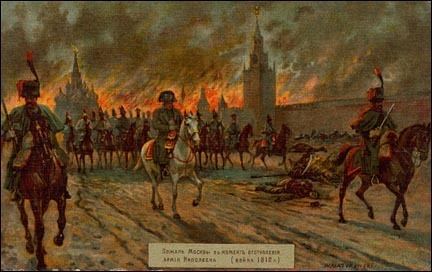
The catastrophe started as many small fires, which promptly grew out of control and formed a massive blaze. The fires spread quickly since most buildings in Moscow were made of wood. And although Moscow had a fire brigade, their equipment had previously either been removed or destroyed on Rostopchin's orders. When Napoleon retreated to a castle outside the city, his troops finally lost their discipline and began to loot and pillage all across Moscow. Even hard punishments could not prevent the plundering, beating or raping of Moscow's citizens by French soldiers during the fire. The flames spread into the Kremlin's arsenal, but the fire was put out by French Guardsmen. The burning of Moscow is reported to have been visible up to 215 km away.
Tolstoy, in his novel War and Peace, suggests that the fire was not deliberately set, either by the Russians or the French, but was the natural result of placing a deserted and mostly wooden city in the hands of invading troops, when fires start nearly every day even with the owners present and a fully functioning police department, and that the soldiers will start fires–from smoking their pipes, cooking their food twice a day, and burning enemy's possessions in the streets. Some of those fires will inevitably get out of control. Without an efficient firefighting action, these individual building fires will spread to become neighborhood fires, and ultimately a citywide conflagration.
Timeline of events
Dates in Gregorian calendar (new style) and numbers referenced to Clausewitz and Tarle
Extent of the disaster
Ivan Katayev (1911) summarized losses as 3/4 of all properties in the city:
Some 12,000 bodies were recovered of which an estimated 2,000 were wounded Russian soldiers perished in the fire. Moscow State University, Buturlin's library, Petrovsky and Arbatsky theaters were completely destroyed; many pieces of art, notably the source manuscript of epic poem The Tale of Igor's Campaign, were lost forever. The Moscow Orphanage near Kitai-gorod, converted to a hospital, was saved by local police. The population of Moscow in 1811 is estimated at 270,000; after the war, when residents returned to the city, it decreased to 215,000; by 1840, it had increased to 349,000.
Maps compiled by Russian authorities after the war (notably the 1817 military map reprinted for the public in the 1831 guide book) show that the majority of Moscow territory had succumbed to the fire. Notable exceptions are Moscow Kremlin, the Orphanage, northern segment of Bely Gorod from Tverskaya Street to Pokrovka Street, Patriarshy Ponds in the west, as well as suburban settlements.
The map probably exaggerates the damage, showing some surviving blocks as if they were destroyed. For instance, Bolshaya Nikitskaya Street west from Boulevard Ring retained many of its mansions: troops defended their own lodgings and the French theatre, as well as the French colony in Kuznetsky Most. On the other hand, French patronage did not help the Batashov Palace (present-day Yauzskaya Hospital), occupied by Murat's headquarters: after two days of firefighting, it was consumed by fire that razed Taganka. Still, the remaining buildings had enough space for the French army. As General de Marbot reasoned,
"It is often claimed that the fire of Moscow… was the principal cause of the failure of the 1812 campaign. This assertion seems to me to be contestable. To begin with, the destruction of Moscow was not so complete that there did not remain enough houses, palaces, churches and barracks to accommodate the entire army [for a whole month]."
However, many units were stationed not in the city, but in remote suburbs like Ostankino (light cavalry) or Khimki (Italian corps); others were dispatched south to screen Russian movements.
Reconstruction of the city
A shortage of funds, state and private, delayed reconstruction of Moscow by at least five years. In those years, many properties were sold by ruined owners, and whole neighborhoods changed their social status; for example, all properties on once-diverse Maroseika Street were bought out by the merchant class.
The disaster allowed the authorities a unique opportunity to plan the city from scratch. In February, 1813, Alexander I of Russia set up the Commission of Building in Moscow, with the instruction to produce a viable master plan for the city. The 1813 plan by William Hastie was deemed inadequate for the task, thus the Commission hired numerous local architects and topographers who produced the final, 1817, master plan (incorporating Hastie's ideas of clearing the Central Squares of Moscow). In 1816–30, city planners set up the Garden Ring, a circular highway in place of an old fortification rampart, and widened many other streets.
Later in 1817, the city held groundbreaking ceremony for Alexander Witberg's Cathedral of Christ the Saviour, a monument to the 1812 War in Sparrow Hills. This project was later canceled and the current Cathedral emerged in the center of Moscow.
Reconstruction of Red Square and Kitai-gorod was handled by Joseph Bove, who designed the neoclassical Upper Trade Rows as a mirror of Matvey Kazakov's Kremlin Senate. In February 1818, Ivan Martos completed the Monument to Minin and Pozharsky, the first public monument in Moscow, placed in the center of Red Square. Bove also designed the symmetrical Theatre Square and completed Bolshoi and Maly theaters by 1825. Moscow University and other public buildings were rebuilt by Domenico Giliardi and Afanasy Grigoriev.
Bove also handled the "façade department", authorizing façade designs for all new buildings. A severe shortage of brick, stone and cement forced many developers to build in wood; the city had to agree with the inevitable, on condition that the houses follow the neoclassical standards. Local craftsmen responded with mass-produced wooden imitations of classical ornaments. Most of these houses were eventually destroyed. Extant examples include a recently restored house on the corner of Glazovsky and Denezhny Lanes in Arbat District, and Vasily Pushkin house in Staraya Basmannaya Street.
